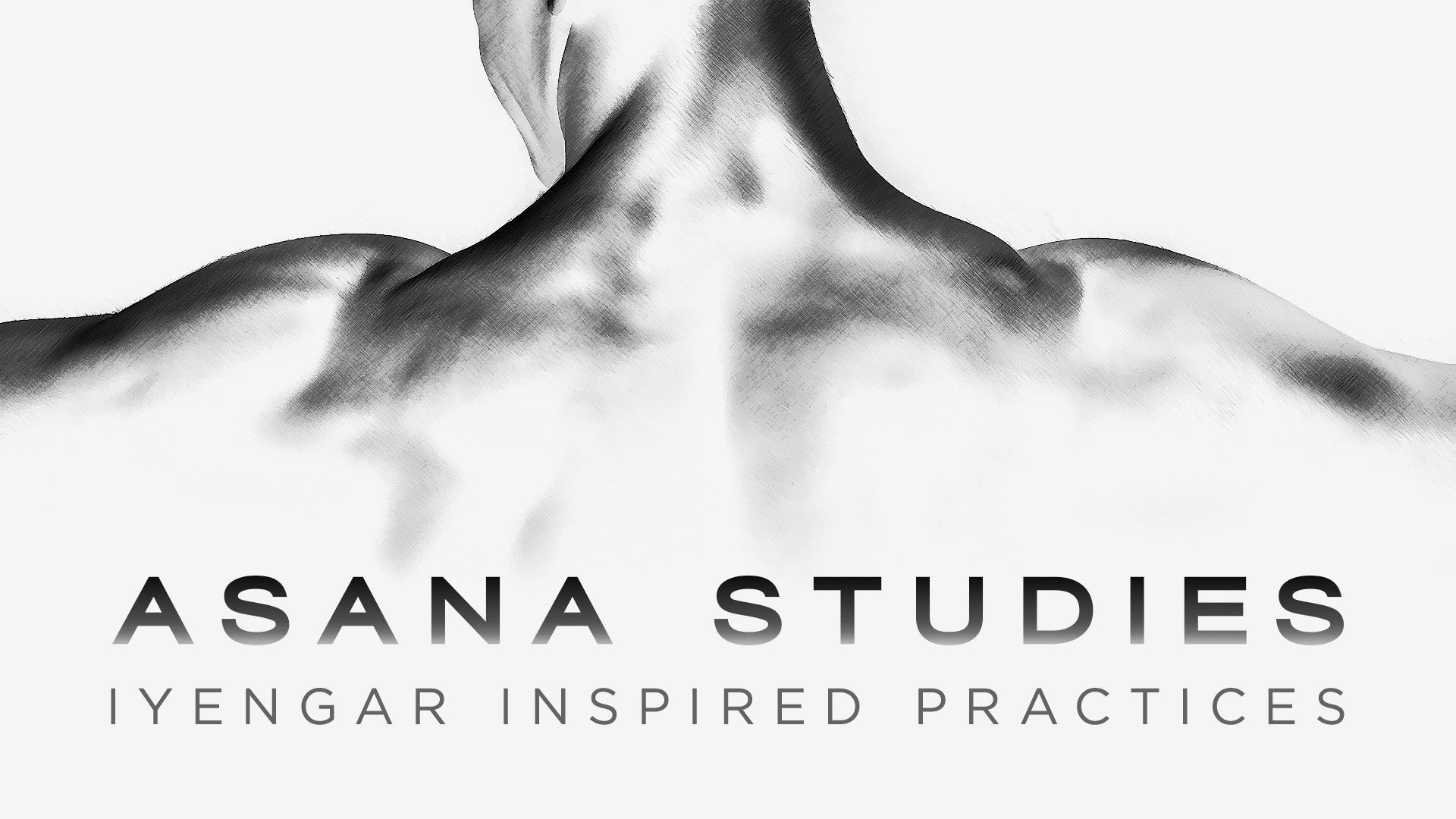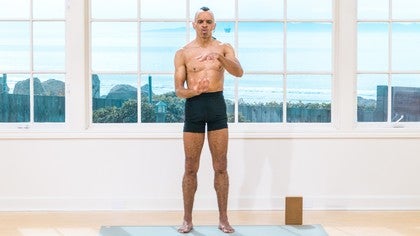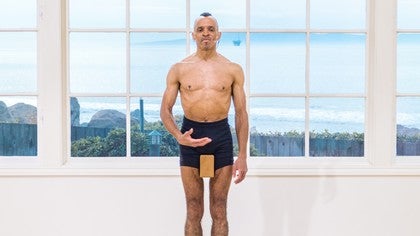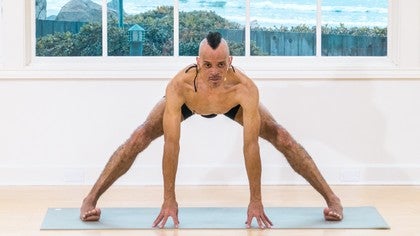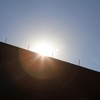Description
About This Video
Transcript
Read Full Transcript
(waves crashing) Hello. Now we're going to take a look at active tadasana. So, one of the ways to look at experiencing the body and working the body is from the standpoint of the elements. For the sake of this portion of the class, we'll just look at the legs being earth, and the pelvis being fluid, water. What we want to do when we work this way is get a sense that those two are together, those two are together in some degree of relative balance and harmony.
Those elements, they maintain, they're throughout the course of our walking, sleeping, eating, sitting, driving, parenting, partying, having fun, playing sports, activities throughout the course of the day, period of our lives, those elements maintain. We want to use the standing poses to accentuate those elements, but also to make use of those elements and how they are inherently there, and how they benefit us and how they create an environment in which we can be at ease in our bodies, in our presence, as we interact with the world around us. So, legs are earth, the pelvis is fluid, water. So we'll deal with the legs first. The legs actually are interesting.
They are designed to take us from one place to another. Basically, locomotive movement. They take us from one place to another. The legs are interesting because we take them and we take the feet, often times, for granted. Well, we take a lot of things for granted until we don't have them, but the legs often times we do.
What we want to do is, is work with the feet and legs in a way that is very deliberate, and where we really allow our consciousness to flood down into them and to accentuate their quality, the quality of earth, and in this case, since we're doing active work, the active earth quality of the legs. We'll use the feet to do that. So we're going to start with active tadasana, and with active tadasana, we'll approach it very similarly to the way we approach passive tadasana when we come to the mat. So you'll look on the mat where you're going to step. As you step there, look up.
You know it's there, you just saw it's there, you don't need to look at it as you step down. Now, when we do active tadasana, we'll stand the same way as we did with passive tadasana, the feet as close as they can be without the knees and feet touching. The reason I say for this, the purposes of this, we don't have the feet touching or the knees touching is because we want to begin to feel the legs standing as close as they can be to each other, as two columns, the twins, gemini, close, so close that they're almost bonded, almost as if they are together, but not quite together, because we want to still feel their individual actions in relationship to each other for the collective spirit of actively grounding. So we put the feet as close as they can be without them touching, or without the knees touching, whichever happens first with the shape of your legs. And then you feel how the feet are lined up.
Now, we're going to begin to work the feet. I use the term shaping the feet. You're going to lift the toes up very wide, don't look at them, just the toes are very wide, as far as they can come up towards your front body, towards the front of your pelvis, towards your chin, towards you face as possible, so toes very high, and the big toes go towards each other, little toes go toward the side walls, so we spread the toes as wide as we can, so we're creating a lot of space between the toes. In fact, we want to create as much space between the toes, as much space as the toes that creates the space that we're filling between the toes. You do that for a few moments, just to feel, from that action, how the feet are in relationship to each other, and then when you know, from doing that, how they are, when you think you know, you can look and see if they are in the relationship you think they are.
Now, if they're not, look at them, adjust them. And then look back up, and feel the difference. Now again, like passive tadasana, if what you looked at was not what you thought you had from just feeling, and from looking you adjusted it and lined it up so that it is aligned, then you look up again and it feels very strange, that's okay, because you just saw, you visually verified that they are indeed lined up, so you want to reference, even if it feels very strange, you want to reference that second feeling, that post look feeling, because that's what you'll go for next time. So, we're shaping the feet, the toes are very wide, spreading the toes very wide, okay. So we do that.
So the feet, by way of the legs, eventually shape the pelvis, and the feet direct the lines of energy in the legs. So we're lifting the toes up. As the toes lift, the energy comes up the front of the legs, and we strengthen the thigh muscles, so if you look at my thighs, how jiggly and relaxed they are, and then as I begin to shape the feet, the old school cue for this, back in the old days, is lift the kneecaps, but you'll strengthen the thigh muscles, okay. So the thighs then go from being soft to being, pretty solid. Now, in passive tadasana we made a big emphasis of feeling the bones carrying the weight.
As we being to work now in active tadasana, and use the muscles and the action of the muscles along the bones, we want to take care that we still experience the bones carrying the weight. That's why it's very important to spend a lot of time practicing passive tadasana, because you want to have a strong foundation in your sense feeling of what it is to have the bones carry the weight, so as you begin to work the muscles, the muscles don't obfuscate that feeling. You want that feeling of the bones clearly carrying the weight. By the way, it's important to realize, bones carry weight, muscles don't carry weight. Bones move, muscles, rather, move the bones and the weight that they carry.
Muscles hold the bones and the weight that they carry in specific relationships, and muscles may work really, really hard doing that in some shapes, but principally, muscles don't carry weight. Bones carry weight. So as we begin to do the shaping of the feet, lifting the toes up, drawing the energy up the front of the legs, strengthening the thigh muscles in active tadasana, we want to do it so that the bones work, the muscles rather work along the bones, work in concert with the bones, and we don't begin to have a sense in our feeling that the muscles, or the weight is being no longer carried by the bones, but by the muscles. So the energy comes up the front of the legs by lifting the toes up and spread them, and then from there we take from below the buttocks, down the back of the legs through the heels into the floor, we take and project energy. Just as if you were to push your hand away like so.
Just as if you were to push your hands to the side and your arms to the side, you want to feel that from below your buttocks down the back of your legs through the heels into the floor. You just lift up the toes, and the shaping of the feet, and the pressing of the heels on the floor to accentuate that quality. Now, as you do this, the butt is relaxed, the buttocks is very relaxed, very relaxed here. So the energy goes down the back of the legs through the heels. It comes up the front of the legs.
So from the side, it's as if you saw a tall oval, down the back of the legs through the heels, up the front of the legs. So we really want to feel as we do this the weight being actively conveyed from the shaping of the feet through the heels into the floor. The energy goes down the back of the legs through the heels into the floor. The next part of this is we'll use the energy through the heels and the floor to stand us more upright from the floor. So, that might be interpreted as if you were to slightly bend your knees and you were to use the energy through your heels and the floor as we shape the feet to push the heels in the floor, to straighten the legs and keep that going once the legs are straight.
As we do this, we have the sense of the buttocks as relaxed and the pelvis has a sense of softness around it. You'll feel some of the muscles around the outer, upper thighs and the outer pelvis contracting. That's okay, but we want us to have a sense of softness here in the groins, and softness around the buttocks. Down the back of the legs, through the heels, standing upright. The next part is using the active energy from shaping the feet, conveyed through the heels and the floor, to move the top of the thigh bones from the heels and the floor, the top of the thigh bones, below the buttocks, back to the wall behind you.
Now, when you do that movement, you move the thigh bones back, you may feel like your pelvis tilts forward. That's okay, don't worry about that too much for now. So you move the thigh bones back. If you're not sure about how to do that, you can keep shaping the feet, slightly bend the knees, you take the fingertips like so, horizontally, right below the buttocks, the very top of the hamstring, with the knees slightly bent, with the toes, press the heels on the floor, and from the heels pressing the floor, begin to move the top of the thigh bones back. This is very important, because we want to feel that we can use the heels to move the top of the thigh bone back, not the knee back.
Principally what we're doing when we're doing active tadasana is beginning to use the feet, by way of the legs, to shape the pelvis, and the feet, on the way to shaping the pelvis by way of the legs, to shape first the legs, and the heels, the active weight in the heels is conveyed to the floor from the shaping of the feet to direct the top of the thigh bones. So the heels, in active tadasana, are like the master conductor. The heels are directing the top of the thigh bones, and you'll see the heels are directing other things too. So just to review up to this point. We see where we're going to step.
As you step there, don't look. Take a few moments and feel, with the feet passive, the feet as close as they can be without them, the feet, touching, or the knees, whichever happens first. And then, without looking, we'll begin to shape the feet, lift the toes up and spread them wide, spreading the toes very wide, so fanning the bones in the feet in a very magnificent way. So have you ever been to the zoo and see, or perhaps been on safari, and see a hippopotamus yawns, huge expansive yawn, it's like you can crawl into his mouth, his huge big tongue, just massive animal. That's what you want you feet to feel like, they're just yawning, a big stretching yawn, the toes very wide, the space between the toes very apparent.
The big toes coming toward each other, little toes going toward the side walls, and then from there, when you think you know, look and see. You're looking to see if you think, from shaping the feet, they were aligned the way you thought they were. If they aren't, when you look at them, refine the alignment of them so they're lined up, and then feel the difference. Keep shaping the feet, and begin from shaping the feet, drawing the energy from lifting the toes, from below the buttocks, and project energy from below the buttocks down the back of the legs, through the heels into the floor. And then use the weight, as it goes actively conveyed from the feet into the floor to stand you upright away from the floor.
Third thing is to use the active energy conveyed from the shape of the feet through the heels and the floor to move the top of the thigh bones below the buttocks back to the wall behind you. So it's down the back of the legs, through the heels, standing you upright, moving the top of the thigh bones back. Now, the next thing is to keep the feet active, use the heels for the next action, which is to scruff the heels apart. Now, the scruffing happens when the heel skin sticks on the floor, on the mat, where it is, and the heel bones within the heel skin sticking on the floor, on the mat where they are, the heel bones slide apart. So if you were on a slippery surface, your heels would slip apart, but they don't, because the skin sticks.
So we get the benefit from that grounding of the skin on the floor, and we work with that grounding, to keep the skin there, to scruff the heels apart. When we scruff the heels apart, it causes the legs to slightly internally rotate, we'll have this shaping begin to happen. So essentially, what we start to get into when we do the foot and leg shaping is the three-dimensional shaping action of the legs as created by the feet and directed by the heels. So down the back of the legs, through the heels, standing upright, moving the top of the thigh bones below the buttocks back to the wall behind you, and then scruff the heels apart, when the heel skin sticks, and the heel bones within the stickiness of the heel skin on the floor slide away from each other. So, hopefully you can see that.
I'm illustrating it sort of in a percussive way, but you do it gradually, in a sustained way. Now the next thing we do is use the heels pressing the floor to lift slightly the outer arches. Now, when we lift the outer arches, you don't actually roll and lift the base of the little toe off the floor, or the whole outer edge of the foot off the floor. You life the outer arch slightly, so the heels scruff apart, and you use the heels pressing the floor, as you're scruffing them apart, to lift the outer arches just a little bit, and then you add the next thing, the last piece, which is, as the heels scruff apart, lift the outer arches, the last thing is to spin the knees slightly out, which is a slight external rotation of the knees. Now, this is tricky, it takes patience, but if you look at my legs, I scruff the heels apart, I lift the outer arches, and when I spin the knees out, you spin the knees out just a little bit, watch, just a little bit, you may not even see that.
You don't spin the knees out so much so that the heels, watch the heels, begin to come together. The heels keep going apart, and the knees spin out slightly. So you're scruffing the heels, lifting the outer arches, and spinning the knees out. If you feel that you spin the knees out and the heels come together, then don't spin the knees out so much. If you feel like you can't put the two together, be very clear the heels go apart, and get the sense, and just kind of pretend that the knees spin out.
So when you practice asana, it's really neat, because you can use tricky psychological, tricky mental inferences, images, and ideas, thoughts and impetus of thought to create qualities of experience in the body. The mind and body are so intimately intertwined. So if you're doing this, you shape the feet, you took the energy down the back of the legs, through the heels into the floor, you pushed the heels in the floor to stand you upright, use the heels through the floor to move the top of the thigh bones below the buttocks back to the wall behind you, use the heels and energy through the floor and the heels to scruff the heels apart, to lift the outer arches, and to spin the knees out. Here's where it gets tricky. Well, the whole thing can be tricky, but here it gets very tricky.
Keep the heels going apart as you spin the knees out. If you feel like you can't get a sense of spinning the knees out, pretend that the knees are spinning out. So, if I were to illustrate that in a very gross way, what the knee spinning out is, it would be this, see them doing that? That's a percussive version of that. But the heels go one way, and the knees go the other way.
So when you do active tadasana, we layer the actions, we first layer the actions. It's down the back of the legs, through the heels, standing you upright away from the floor, using the heels and the floor to move the top of the thigh bones below the buttocks back to the wall behind you, scruffing the heels apart, lifting the outer arches, and spinning the knees out. We first learn how to layer the actions, and then we begin to, as we practice, allow the actions, and this will happen naturally, they will begin to blend, so it'll be kind of a chord, like a musical chord, multiple notes happening at the same time, but at first, you layer the tones, you layer the notes, and you do them slowly, a couple at a time, okay? So, we'll review. Patience, it takes patience, practice and patience.
Move into place, look where you're going to stand. When you go to step there, don't look. Floor's down there, you know it's there, you saw it, you know there's nothing to step in, don't worry about it, just step there. Put the feet, with them relaxed, as close as they can be without the knees or feet touching, for a few moments with them relaxed. Then begin lifting the toes up to shape the feet, and then from there, when you think you know what you have, look to see if what you're doing is what you think you are.
If not, adjust it while you look, and then when you look up again, feel the difference. The second feeling you have, the post look feeling you had is the feeling you're going to reference going forward, even if it's very strange, feels very wrong, you just saw that it is what it is, so go with it. Shape the feet then, lift the toes, shape the feet, the toes very wide, the big toes going towards each other, little toes going as far as they can towards the right and left walls. Keep shaping the feet, and then use the lift in the toes to draw energy from below the buttocks down the back of the legs through the heels into the floor below you, and use the active energy from the shaping of the feet going from the heels into the floor, the grounding energy to move the top of the thigh bones below the buttocks back to the wall behind you, and then scruff the heels apart, as the heel skin sticks, the heel bones within the heel skin sticking on the floor slide away from each other. Use the heels pressing to lift the outer arches a little bit, and then spin the knees out.
Scruff the heels, lift the outer arches, spin the knees out. So we get this kind of thing going on. This leads into pelvic shaping. Down the back of the legs, through the heels, standing you upright, moving the top of the thigh bones back, scruffing the heels, lifting the outer arches, spinning the knees out. One other point.
There's a lot of discussion about, or languaging around how to use the legs and whether they're straight and or locked, okay. I make a distinction between straight legs and locked legs. For instance, I will show you. My knees doing this are locked, whether it's percussively so, or whether it's in a sustained way, they're locked. I've used the weight in my heels, working with the same techniques, the same approach, by shaping the feet, I use the weight in my heel to move the top, rather the knee back.
The knee back, which locks the leg. The knee joint is locked, okay. What I want to do is use the weight in the heel to start to identify the top of the thigh bone to move the top of the thigh bone back. Now, if I move the top of the thigh bone back, and keep moving the top of the thigh bone back, the knee will follow, but the top of the thigh bone will precede the movement back from the weight in the heel into the floor. So now, my leg is straight, but it's not, see if you can see the difference.
Locked. So the straight leg is powerful, it's energetic, and the energy on the front of the leg and the back of the leg tends to be more balanced than if it were locked, with the energy on the front of the leg, the action, the muscular action in the front of the leg is so hyper and so powerful that the knee feels like it's jammed, okay. So, I'm straightening the legs, but not locking the legs, there's a distinction. I make the distinction, and I'd like you to learn how to make the distinction, too. Okay.
Active tadasana, thank you, namaste.
Asana Studies: Chris Hoskins
Comments
Thanks for doing your practice. It’s fantastic that this has breathed new life into your Tadasana! Active Tadasana practiced this way is quite a multi-dimensionally dynamic pose, but it is a bit tricky. The challenge you described of maintaining the opposing actions of the movement of the heels and knees is one of the trickiest parts of it.
Perhaps if you play with the actions while sitting on a chair, and then crouched in Utkatasana, you will be able to transfer them to Tadasana. Keep in mind that the wave of inhalation is generally the breath support movement that is affined with spinning the knees out.
You need to be a subscriber to post a comment.
Please Log In or Create an Account to start your free trial.
